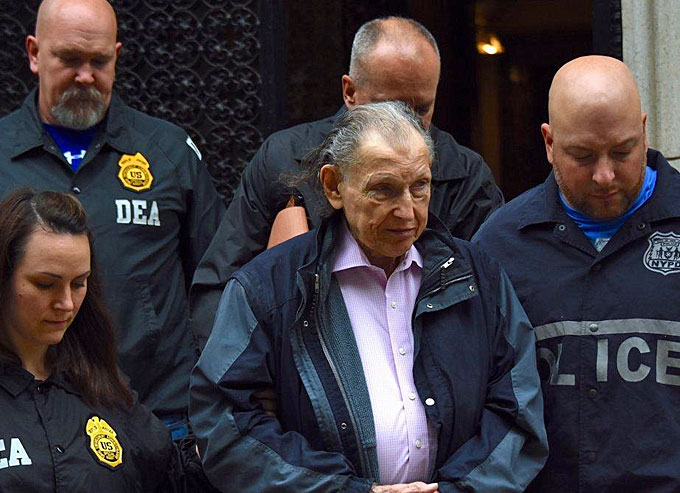
Over 45 days in February and March, the U.S. Drug Enforcement Administration (DEA) surged its enforcement and administrative resources to identify and investigate prescribers and pharmacies that dispensed disproportionately large amounts of drugs.
The ultimate goal of the DEA surge efforts was remediating or removing those whose actions perpetuate the controlled prescription drug crisis in America, particularly opioid drugs.
(Learn More. Attorney General Jeff Sessions says the new Opioid Fraud and Abuse Detection Unit will target medical providers who are illegally prescribing opioids and contributing to the epidemic. Sessions will also appoint 12 prosecutors to exclusively investigate such fraud cases. Courtesy of NBC News and YouTube. Posted on Aug 2, 2017)
Over the course of investigations, the DEA surged the efforts of special agents, diversion investigators, and intelligence research specialists to analyze 80 million transaction reports from DEA-registered manufacturers and distributors.
In addition, investigators reviewed reports submitted on suspicious orders and drug thefts and information shared by federal partners, such as the Department of Health and Human Services.

The described efforts have resulted in the development of 366 leads to DEA field offices, 188 of which (51 percent) resulted in active investigations by DEA’s 22 field divisions.
“DEA will use every criminal, civil, and regulatory tool possible to target, prosecute and shut down individuals and organizations responsible for the illegal distribution of addictive and potentially deadly pharmaceutical controlled substances,” said Acting DEA Administrator Robert W. Patterson.
“This surge effort has demonstrated an effective roadmap to proactively target illicit diversion of dangerous pharmaceuticals.”
“DEA will continue to aggressively use this targeting playbook in continuing operations. Attorney General Sessions and the Department of Justice have provided tremendous leadership and support in this critical mission.”
“We must stop the loss of our loved ones to these drugs.”
(Opioid overdose emergency department visits rose 30% in all parts of the U.S. from July 2016 through September 2017. Courtesy of the Centers for Disease Control and Prevention (CDC) and YouTube. Posted on Mar 6, 2018)
The culmination of those investigations under the previously described surge was 28 arrests, 54 other enforcement actions including search warrants and administrative inspection warrants, and 283 administrative actions of other types.
These additional actions included scheduled inspections, letters of admonition, memoranda of agreement/understanding, surrenders for cause of DEA registrations, orders to show cause, and immediate suspension orders (the immediate revocation of registrations).
The DEA works with various federal and state partners on data sharing agreements to enhance its ability to identify individuals and companies who are contributing to the prescription opioid crisis, including a coalition of 41 state attorneys general and the Department of Justice’s Opioid Fraud and Detection Unit, an initiative of Attorney General Jeff Sessions.
(Learn More. The Department of Justice’s new Opioid Fraud and Abuse Detection Unit is actively investigating cases in Northeast Tennessee, Knoxville and Chattanooga, according to U.S. Attorney Nancy Harr. Courtesy of WJHL and YouTube. Posted on Nov 20, 2017)
It is also dedicating additional resources to its domestic divisions to carry out investigations.
The DEA recently announced the agency will add 250 task force officers and dozens of additional analysts to areas across America where the opioid crisis is at its worst.
DEA task forces act as a force multiplier in carrying out DEA’s mission through coordination and cooperation with federal, state, and local law enforcement agencies in the U.S. Historically, DEA task force officers have been some of the most essential and effective partners in building cases against drug trafficking organizations across the globe.
(“It’s a cheap way for the dealers to make money. They don’t care if they’re killing people, they really don’t.”. Courtesy of Elite Daily and YouTube. Posted on Jan 11, 2018)
“DEA highly values its partnerships with task force officers and their parent agencies,” explained Patterson.
“These additional assets will strengthen the work DEA is already doing every day to make a difference in the fight against opioid abuse.”
“Positioning more robust resources such as task force officers in areas hardest hit by this epidemic will provide the strength and support needed to tackle this crisis in regions that need it most.”
(Learn More. See various exercises associated with DEA agent training. Courtesy of the DEA, GreatAmericans DotCom and YouTube. Posted on Jul 3, 2017)
















